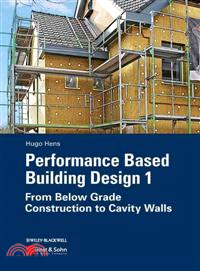Performance Based Building Design 1 - From Below Grade Construction To Cavity Wall
商品資訊
相關商品
商品簡介
作者簡介
目次
商品簡介
Just like building physics, performance based building design was hardly an issue before the energy crises of the 1970ies. With the need to upgrade energy efficiency, the interest in overall building performance grew. As the first of two volumes, this book applies the performance rationale, advanced in applied building physics, to the design and construction of buildings. After an overview of materials for thermal insulation, water proofing, air tightening and vapour tightening and a discussion on joints, building construction is analysed, starting with the excavations. Then foundations, below and on grade constructions, typical load bearing systems and floors pass the review to end with massive outer walls insulated at the inside and the outside and cavity walls. Most chapters build on a same scheme: overview, overall performance evaluation, design and construction.
This third book, after Building Physics and Applied Building Physics, is the result of 38 years of teaching architectural, building and civil engineers, coupled to more than 40 years of experience in research and consultancy. Where and when needed, input and literature from over the world was used, reason why each chapter ends listing references and literature.
The book should be usable by undergraduates and graduates in architectural and building engineering, though also building engineers, who want to refresh their knowledge, may benefit. The level of discussion assumes the reader has a sound knowledge of building physics, along wit a background in structural engineering, building materials and building construction.
This third book, after Building Physics and Applied Building Physics, is the result of 38 years of teaching architectural, building and civil engineers, coupled to more than 40 years of experience in research and consultancy. Where and when needed, input and literature from over the world was used, reason why each chapter ends listing references and literature.
The book should be usable by undergraduates and graduates in architectural and building engineering, though also building engineers, who want to refresh their knowledge, may benefit. The level of discussion assumes the reader has a sound knowledge of building physics, along wit a background in structural engineering, building materials and building construction.
作者簡介
Prof. Em. Dr. Ir. Hugo S.L.C. Hens, University of Leuven (KULeuven, Belgium), taught Building Physics from 1975 to 2003, Performance Based Building Design from 1970 to 2005 and Building Services from 1975 to 1977 and 1990 to 2008. Until 1972, he worked as a structural engineer at a mid-sized architectural company, constructing houses, apartment buildings and office buildings. He has authored and co-authored over 150 articles and conference papers, and written hundreds of reports on building damage cases and their solution. He has been coordinating the international working group CIB W40 on Heat and Mass Transfer in Buildings for ten years. Between 1986 and 2008, he was operating agent of four Annexes, initiated by the International Energy Agency’s EXCO on Energy Conservation in Buildings and Community Systems: Annex 14, Annex 24, Annex 32 and Annex 41. He is also a fellow of the American Society of Heating, Refrigeration and Air Conditioning Engineers (ASHRAE).
目次
Preface XIII
0 Introduction 1
0.1 Subject of the book 1
0.2 Units and symbols 1
0.3 References and literature 5
1 Performances 7
1.1 In general 7
1.2 Definitions and basic characteristics 7
1.3 Advantages 7
1.4 Performance arrays 7
1.5 Design based on performance metrics 10
1.5.1 The design process 10
1.5.2 Integrating a performance analysis 10
1.6 Impact on the building process 11
1.7 References and literature 11
2 Materials 13
2.1 In general 13
2.2 Array of material properties 13
2.3 Thermal insulation materials 14
2.3.1 Introduction 14
2.3.2 Apparent thermal conductivity 14
2.3.2.1 In general 14
2.3.2.2 Impact of the transport modes 14
2.3.3 Other properties 19
2.3.3.1 Mechanical 19
2.3.3.2 Physical 19
2.3.3.3 Fire 20
2.3.3.4 Sensitivity to temperature, IR and UV 20
2.3.4 Materials 20
2.3.4.1 Insulating building materials 20
2.3.4.2 Insulation materials 23
2.3.4.3 Insulating systems 34
2.3.4.4 Recent developments 35
2.4 Water, vapour and air flow control layers 37
2.4.1 In general 37
2.4.2 Water barriers 38
2.4.2.1 A short history 38
2.4.2.2 Bituminous membranes 39
2.4.2.3 Polymer-bituminous membranes 39
2.4.2.4 High-polymer membranes 41
2.4.3 Vapour retarders and vapour barriers 42
2.4.4 Air barriers 44
2.5 Joints 44
2.5.1 In general 44
2.5.2 Joint solutions and joint finishing options 45
2.5.3 Performance requirements 46
2.5.3.1 Mechanical 46
2.5.3.2 Building physics related 46
2.5.4 Sealant classification 46
2.5.5 Load and sealant choice 48
2.5.6 Structural design of sealed joints 49
2.5.7 Points of attention 50
2.6 References and literature 51
3 Excavations and building pit 55
3.1 In general 55
3.2 Realisation 55
4 Foundations 57
4.1 In general 57
4.2 Performance evaluation 57
4.2.1 Structural integrity 57
4.2.1.1 Equilibrium load bearing capacity 57
4.2.1.2 Settling load bearing capacity 58
4.2.2 Building physics 60
4.2.3 Durability 60
4.3 Foundation systems 61
4.3.1 In general 61
4.3.2 Spread foundations 61
4.3.2.1 Footings 61
4.3.2.2 Foundation slabs 63
4.3.2.3 Soil consolidation 63
4.3.3 Deep foundations 63
4.3.3.1 Wells 63
4.3.3.2 Piles 64
4.4 Specific problems 65
4.4.1 Eccentrically loaded footings 65
4.4.2 Footings under large openings 66
4.4.3 Reinforcing and/or deepening existing foundations 66
4.4.3.1 Footings 66
4.4.3.2 Wells 67
4.4.3.3 Pressed piles 67
4.5 References and literature 68
5 Building parts on and below grade 69
5.1 In general 69
5.2 Performance evaluation 69
5.2.1 Structural integrity 69
5.2.1.1 Static stability 69
5.2.1.2 Strength and stiffness 70
5.2.2 Building physics, heat, air, moisture 71
5.2.2.1 Air tightness 71
5.2.2.2 Thermal transmittance 73
5.2.2.3 Transient response 88
5.2.2.4 Moisture tolerance 91
5.2.2.5 Thermal bridging 98
5.2.3 Building physics: acoustics 100
5.2.4 Durability 101
5.2.5 Fire safety 101
5.2.6 Soil gases 101
5.3 Design and execution 101
5.3.1 Basements 101
5.3.2 Drainages 102
5.3.2.1 In general 102
5.3.2.2 Properties 103
5.3.2.3 Design 103
5.3.3 Waterproof encasement 105
5.3.3.1 Inside 105
5.3.3.2 Outside 107
5.3.4 Waterproof concrete 108
5.4 References and literature 109
6 Structural options 111
6.1 In general 111
6.2 Performance evaluation 112
6.2.1 Structural integrity 112
6.2.2 Fire safety 113
6.3 Structural system design 115
6.3.1 Vertical loads 115
6.3.2 Horizontal load 116
6.3.2.1 Massive structures 116
6.3.2.2 Skeleton structures 119
6.3.3 Dynamic horizontal loads 121
6.4 References and literature 121
7 Floors 123
7.1 In general 123
7.2 Performance evaluation 124
7.2.1 Structural integrity 124
7.2.2 Building physics: heat-air-moisture 125
7.2.2.1 Air tightness 125
7.2.2.2 Thermal transmittance 126
7.2.2.3 Transient response 128
7.2.2.4 Moisture tolerance 129
7.2.2.5 Thermal bridging 135
7.2.3 Building physics: acoustics 136
7.2.3.1 Airborne noise 136
7.2.3.2 Impact noise 136
7.2.4 Durability 137
7.2.5 Fire safety 138
7.3 Design and execution 139
7.3.1 In general 139
7.3.2 Timber floors 140
7.3.2.1 Span below 6 m 140
7.3.2.2 Spans above 6 m 142
7.3.3 Concrete slabs and prefabricated structural floor units 142
7.3.3.1 Span below 6 m 142
7.3.3.2 Span above 6 m 145
7.3.4 Steel floors 146
7.3.4.1 Span below 6 m 146
7.3.4.2 Span above 6 m 146
7.4 References and literature 147
8 Outer wall requirements 149
8.1 In general 149
8.2 Performance evaluation 149
8.2.1 Structural integrity 149
8.2.2 Building physics: heat, air, moisture 150
8.2.2.1 Air tightness 150
8.2.2.2 Thermal transmittance 151
8.2.2.3 Transient response 152
8.2.2.4 Moisture tolerance 153
8.2.2.5 Thermal bridging 153
8.2.3 Building physics: acoustics 153
8.2.4 Durability 154
8.2.5 Fire safety 155
8.2.6 Maintenance and economy 155
8.3 References and literature 155
9 Massive outer walls 157
9.1 Traditional masonry walls 157
9.1.1 In general 157
9.1.2 Performance evaluation 157
9.1.2.1 Building physics: heat, air, moisture 157
9.1.2.2 Building physics: acoustics 160
9.1.2.3 Durability 160
9.1.2.4 Fire safety 160
9.1.3 Conclusion 160
9.2 Massive light-weight walls 160
9.2.1 In general 160
9.2.2 Performance evaluation 161
9.2.2.1 Structural integrity 161
9.2.2.2 Building physics: heat, air, moisture 162
9.2.2.3 Building physics: acoustics 170
9.2.2.4 Durability 171
9.2.2.5 Fire safety 172
9.2.2.6 Maintenance 172
9.2.3 Design and execution 172
9.2.3.1 In general 172
9.2.3.2 Specific 173
9.3 Massive walls with inside insulation 174
9.3.1 In general 174
9.3.2 Performance evaluation 174
9.3.2.1 Structural integrity 174
9.3.2.2 Building physics: heat, air, moisture 174
9.3.2.3 Building physics: acoustics 190
9.3.2.4 Durability 190
9.3.2.5 Fire safety 191
9.3.2.6 Global conclusion 192
9.3.3 Design and execution 192
9.4 Massive walls with outside insulation 194
9.4.1 In general 194
9.4.2 Performance evaluation 195
9.4.2.1 Structural integrity 195
9.4.2.2 Building physics: heat, air, moisture 195
9.4.2.3 Building physics: acoustics 206
9.4.2.4 Durability 207
9.4.2.5 Fire safety 209
9.4.2.6 Maintenance 209
9.4.2.7 Global conclusion 209
9.4.3 Design and execution 209
9.4.3.1 Clad stud systems 209
9.4.3.2 EIFS-systems 210
9.5 References and literature 212
10 Cavity walls 215
10.1 In general 215
10.2 Performance evaluation 217
10.2.1 Structural integrity 217
10.2.2 Building physics: heat, air, moisture 218
10.2.2.1 Air tightness 218
10.2.2.2 Thermal transmittance 221
10.2.2.3 Transient response 234
10.2.2.4 Moisture tolerance 235
10.2.2.5 Thermal bridges 244
10.2.3 Building physics: acoustics 244
10.2.4 Durability 245
10.2.1 Fire safety 246
10.2.1 Maintenance 246
10.3 Design and execution 247
10.3.1 New construction 247
10.3.1.1 Airtight, as few thermal bridges as possible 247
10.3.1.2 Correct cavity trays where needed 248
10.3.1.3 Excluding air looping and wind washing 249
10.3.2 Post-filling existing cavity walls 250
10.4 References and literature 251
11 Panelized massive outer walls 255
11.1 In general 255
11.2 Performance evaluation 256
11.2.1 Structural integrity 256
11.2.2 Building physics: heat, air, moisture 257
11.2.2.1 Air tightness 257
11.2.2.2 Thermal transmittance 257
11.2.2.3 Transient response 259
11.2.2.4 Moisture tolerance 259
11.2.2.5 Thermal bridging 260
11.2.3 Building physics: acoustics 260
11.2.4 Durability 260
11.2.5 Fire safety 261
11.2.6 Maintenance 261
11.3 Design and execution 261
11.4 References and literature 262
0 Introduction 1
0.1 Subject of the book 1
0.2 Units and symbols 1
0.3 References and literature 5
1 Performances 7
1.1 In general 7
1.2 Definitions and basic characteristics 7
1.3 Advantages 7
1.4 Performance arrays 7
1.5 Design based on performance metrics 10
1.5.1 The design process 10
1.5.2 Integrating a performance analysis 10
1.6 Impact on the building process 11
1.7 References and literature 11
2 Materials 13
2.1 In general 13
2.2 Array of material properties 13
2.3 Thermal insulation materials 14
2.3.1 Introduction 14
2.3.2 Apparent thermal conductivity 14
2.3.2.1 In general 14
2.3.2.2 Impact of the transport modes 14
2.3.3 Other properties 19
2.3.3.1 Mechanical 19
2.3.3.2 Physical 19
2.3.3.3 Fire 20
2.3.3.4 Sensitivity to temperature, IR and UV 20
2.3.4 Materials 20
2.3.4.1 Insulating building materials 20
2.3.4.2 Insulation materials 23
2.3.4.3 Insulating systems 34
2.3.4.4 Recent developments 35
2.4 Water, vapour and air flow control layers 37
2.4.1 In general 37
2.4.2 Water barriers 38
2.4.2.1 A short history 38
2.4.2.2 Bituminous membranes 39
2.4.2.3 Polymer-bituminous membranes 39
2.4.2.4 High-polymer membranes 41
2.4.3 Vapour retarders and vapour barriers 42
2.4.4 Air barriers 44
2.5 Joints 44
2.5.1 In general 44
2.5.2 Joint solutions and joint finishing options 45
2.5.3 Performance requirements 46
2.5.3.1 Mechanical 46
2.5.3.2 Building physics related 46
2.5.4 Sealant classification 46
2.5.5 Load and sealant choice 48
2.5.6 Structural design of sealed joints 49
2.5.7 Points of attention 50
2.6 References and literature 51
3 Excavations and building pit 55
3.1 In general 55
3.2 Realisation 55
4 Foundations 57
4.1 In general 57
4.2 Performance evaluation 57
4.2.1 Structural integrity 57
4.2.1.1 Equilibrium load bearing capacity 57
4.2.1.2 Settling load bearing capacity 58
4.2.2 Building physics 60
4.2.3 Durability 60
4.3 Foundation systems 61
4.3.1 In general 61
4.3.2 Spread foundations 61
4.3.2.1 Footings 61
4.3.2.2 Foundation slabs 63
4.3.2.3 Soil consolidation 63
4.3.3 Deep foundations 63
4.3.3.1 Wells 63
4.3.3.2 Piles 64
4.4 Specific problems 65
4.4.1 Eccentrically loaded footings 65
4.4.2 Footings under large openings 66
4.4.3 Reinforcing and/or deepening existing foundations 66
4.4.3.1 Footings 66
4.4.3.2 Wells 67
4.4.3.3 Pressed piles 67
4.5 References and literature 68
5 Building parts on and below grade 69
5.1 In general 69
5.2 Performance evaluation 69
5.2.1 Structural integrity 69
5.2.1.1 Static stability 69
5.2.1.2 Strength and stiffness 70
5.2.2 Building physics, heat, air, moisture 71
5.2.2.1 Air tightness 71
5.2.2.2 Thermal transmittance 73
5.2.2.3 Transient response 88
5.2.2.4 Moisture tolerance 91
5.2.2.5 Thermal bridging 98
5.2.3 Building physics: acoustics 100
5.2.4 Durability 101
5.2.5 Fire safety 101
5.2.6 Soil gases 101
5.3 Design and execution 101
5.3.1 Basements 101
5.3.2 Drainages 102
5.3.2.1 In general 102
5.3.2.2 Properties 103
5.3.2.3 Design 103
5.3.3 Waterproof encasement 105
5.3.3.1 Inside 105
5.3.3.2 Outside 107
5.3.4 Waterproof concrete 108
5.4 References and literature 109
6 Structural options 111
6.1 In general 111
6.2 Performance evaluation 112
6.2.1 Structural integrity 112
6.2.2 Fire safety 113
6.3 Structural system design 115
6.3.1 Vertical loads 115
6.3.2 Horizontal load 116
6.3.2.1 Massive structures 116
6.3.2.2 Skeleton structures 119
6.3.3 Dynamic horizontal loads 121
6.4 References and literature 121
7 Floors 123
7.1 In general 123
7.2 Performance evaluation 124
7.2.1 Structural integrity 124
7.2.2 Building physics: heat-air-moisture 125
7.2.2.1 Air tightness 125
7.2.2.2 Thermal transmittance 126
7.2.2.3 Transient response 128
7.2.2.4 Moisture tolerance 129
7.2.2.5 Thermal bridging 135
7.2.3 Building physics: acoustics 136
7.2.3.1 Airborne noise 136
7.2.3.2 Impact noise 136
7.2.4 Durability 137
7.2.5 Fire safety 138
7.3 Design and execution 139
7.3.1 In general 139
7.3.2 Timber floors 140
7.3.2.1 Span below 6 m 140
7.3.2.2 Spans above 6 m 142
7.3.3 Concrete slabs and prefabricated structural floor units 142
7.3.3.1 Span below 6 m 142
7.3.3.2 Span above 6 m 145
7.3.4 Steel floors 146
7.3.4.1 Span below 6 m 146
7.3.4.2 Span above 6 m 146
7.4 References and literature 147
8 Outer wall requirements 149
8.1 In general 149
8.2 Performance evaluation 149
8.2.1 Structural integrity 149
8.2.2 Building physics: heat, air, moisture 150
8.2.2.1 Air tightness 150
8.2.2.2 Thermal transmittance 151
8.2.2.3 Transient response 152
8.2.2.4 Moisture tolerance 153
8.2.2.5 Thermal bridging 153
8.2.3 Building physics: acoustics 153
8.2.4 Durability 154
8.2.5 Fire safety 155
8.2.6 Maintenance and economy 155
8.3 References and literature 155
9 Massive outer walls 157
9.1 Traditional masonry walls 157
9.1.1 In general 157
9.1.2 Performance evaluation 157
9.1.2.1 Building physics: heat, air, moisture 157
9.1.2.2 Building physics: acoustics 160
9.1.2.3 Durability 160
9.1.2.4 Fire safety 160
9.1.3 Conclusion 160
9.2 Massive light-weight walls 160
9.2.1 In general 160
9.2.2 Performance evaluation 161
9.2.2.1 Structural integrity 161
9.2.2.2 Building physics: heat, air, moisture 162
9.2.2.3 Building physics: acoustics 170
9.2.2.4 Durability 171
9.2.2.5 Fire safety 172
9.2.2.6 Maintenance 172
9.2.3 Design and execution 172
9.2.3.1 In general 172
9.2.3.2 Specific 173
9.3 Massive walls with inside insulation 174
9.3.1 In general 174
9.3.2 Performance evaluation 174
9.3.2.1 Structural integrity 174
9.3.2.2 Building physics: heat, air, moisture 174
9.3.2.3 Building physics: acoustics 190
9.3.2.4 Durability 190
9.3.2.5 Fire safety 191
9.3.2.6 Global conclusion 192
9.3.3 Design and execution 192
9.4 Massive walls with outside insulation 194
9.4.1 In general 194
9.4.2 Performance evaluation 195
9.4.2.1 Structural integrity 195
9.4.2.2 Building physics: heat, air, moisture 195
9.4.2.3 Building physics: acoustics 206
9.4.2.4 Durability 207
9.4.2.5 Fire safety 209
9.4.2.6 Maintenance 209
9.4.2.7 Global conclusion 209
9.4.3 Design and execution 209
9.4.3.1 Clad stud systems 209
9.4.3.2 EIFS-systems 210
9.5 References and literature 212
10 Cavity walls 215
10.1 In general 215
10.2 Performance evaluation 217
10.2.1 Structural integrity 217
10.2.2 Building physics: heat, air, moisture 218
10.2.2.1 Air tightness 218
10.2.2.2 Thermal transmittance 221
10.2.2.3 Transient response 234
10.2.2.4 Moisture tolerance 235
10.2.2.5 Thermal bridges 244
10.2.3 Building physics: acoustics 244
10.2.4 Durability 245
10.2.1 Fire safety 246
10.2.1 Maintenance 246
10.3 Design and execution 247
10.3.1 New construction 247
10.3.1.1 Airtight, as few thermal bridges as possible 247
10.3.1.2 Correct cavity trays where needed 248
10.3.1.3 Excluding air looping and wind washing 249
10.3.2 Post-filling existing cavity walls 250
10.4 References and literature 251
11 Panelized massive outer walls 255
11.1 In general 255
11.2 Performance evaluation 256
11.2.1 Structural integrity 256
11.2.2 Building physics: heat, air, moisture 257
11.2.2.1 Air tightness 257
11.2.2.2 Thermal transmittance 257
11.2.2.3 Transient response 259
11.2.2.4 Moisture tolerance 259
11.2.2.5 Thermal bridging 260
11.2.3 Building physics: acoustics 260
11.2.4 Durability 260
11.2.5 Fire safety 261
11.2.6 Maintenance 261
11.3 Design and execution 261
11.4 References and literature 262
主題書展
更多
主題書展
更多書展本週66折
您曾經瀏覽過的商品
購物須知
外文書商品之書封,為出版社提供之樣本。實際出貨商品,以出版社所提供之現有版本為主。部份書籍,因出版社供應狀況特殊,匯率將依實際狀況做調整。
無庫存之商品,在您完成訂單程序之後,將以空運的方式為你下單調貨。為了縮短等待的時間,建議您將外文書與其他商品分開下單,以獲得最快的取貨速度,平均調貨時間為1~2個月。
為了保護您的權益,「三民網路書店」提供會員七日商品鑑賞期(收到商品為起始日)。
若要辦理退貨,請在商品鑑賞期內寄回,且商品必須是全新狀態與完整包裝(商品、附件、發票、隨貨贈品等)否則恕不接受退貨。






















